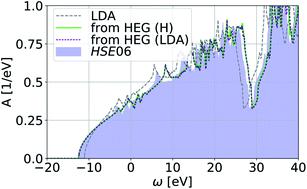当前位置:
X-MOL 学术
›
Faraday Discuss.
›
论文详情
Our official English website, www.x-mol.net, welcomes your feedback! (Note: you will need to create a separate account there.)
Design of auxiliary systems for spectroscopy.
Faraday Discussions ( IF 3.4 ) Pub Date : 2020-06-23 , DOI: 10.1039/d0fd00067a Marco Vanzini 1 , Francesco Sottile , Igor Reshetnyak , Sergio Ciuchi , Lucia Reining , Matteo Gatti
Faraday Discussions ( IF 3.4 ) Pub Date : 2020-06-23 , DOI: 10.1039/d0fd00067a Marco Vanzini 1 , Francesco Sottile , Igor Reshetnyak , Sergio Ciuchi , Lucia Reining , Matteo Gatti
Affiliation

|
The Kohn–Sham system is the prototypical example of an auxiliary system that targets, in principle exactly, an observable like the electronic density without the need to calculate the complicated many-body wavefunction. Although the Kohn–Sham system does not describe excited-state properties directly, it also represents a very successful strategy guideline for many spectroscopy applications. Here we propose a generalization of the Kohn–Sham idea. In many situations one is interested only in limited answers to specific questions, whereas in state-of-the-art approaches a lot of information is generally calculated that is not needed for the interpretation of experimental spectra. For example, when the target is a spectrum S(ω) like the optical absorption of a solid, within time-dependent density-functional theory (TDDFT) one calculates the whole response function χ(r,r′,ω). Analogously, within many-body perturbation theory (MBPT) one calculates the whole one-particle Green’s function G(r,r′,ω), while only the total spectral function A(ω) is needed for angle-integrated photoemission spectra. In this contribution, we advocate the possibility of designing auxiliary systems with effective potentials or kernels that target only the specific spectral properties of interest and are simpler than the self-energy of MBPT or the exchange–correlation kernel of TDDFT. In particular, we discuss the fundamentals and prototypical applications of simplified effective kernels for optical absorption and spectral potentials for photoemission, and we discuss how to express these potentials or kernels as functionals of the density.
中文翻译:

光谱辅助系统的设计。
Kohn-Sham系统是辅助系统的典型示例,该系统原则上精确地瞄准可观测的电子密度,而无需计算复杂的多体波函数。尽管Kohn-Sham系统不能直接描述激发态性质,但它还是许多光谱学应用非常成功的策略指南。在这里,我们提出了Kohn-Sham概念的概括。在许多情况下,人们只对特定问题的有限答案感兴趣,而在最新方法中,通常会计算出很多信息,而这些信息对于解释实验光谱是不需要的。例如,当目标是光谱S(ω)如固体的光吸收一样,在随时间变化的密度泛函理论(TDDFT)中,可以计算整个响应函数χ(r,r',ω)。类似地,在多体扰动理论(MBPT)中,人们只计算整个一粒子格林函数G(r,r',ω),而仅计算总谱函数A(ω角度积分的光发射光谱需要)。在这项贡献中,我们提倡设计具有有效电势或核的辅助系统的可能性,这些核或核仅针对感兴趣的特定光谱特性,并且比MBPT的自能或TDDFT的交换相关核更简单。特别是,我们讨论了用于光吸收的简化有效内核和用于光发射的光谱势的基本原理和原型应用,并讨论了如何将这些势或内核表示为密度函数。
更新日期:2020-06-23
中文翻译:

光谱辅助系统的设计。
Kohn-Sham系统是辅助系统的典型示例,该系统原则上精确地瞄准可观测的电子密度,而无需计算复杂的多体波函数。尽管Kohn-Sham系统不能直接描述激发态性质,但它还是许多光谱学应用非常成功的策略指南。在这里,我们提出了Kohn-Sham概念的概括。在许多情况下,人们只对特定问题的有限答案感兴趣,而在最新方法中,通常会计算出很多信息,而这些信息对于解释实验光谱是不需要的。例如,当目标是光谱S(ω)如固体的光吸收一样,在随时间变化的密度泛函理论(TDDFT)中,可以计算整个响应函数χ(r,r',ω)。类似地,在多体扰动理论(MBPT)中,人们只计算整个一粒子格林函数G(r,r',ω),而仅计算总谱函数A(ω角度积分的光发射光谱需要)。在这项贡献中,我们提倡设计具有有效电势或核的辅助系统的可能性,这些核或核仅针对感兴趣的特定光谱特性,并且比MBPT的自能或TDDFT的交换相关核更简单。特别是,我们讨论了用于光吸收的简化有效内核和用于光发射的光谱势的基本原理和原型应用,并讨论了如何将这些势或内核表示为密度函数。


























 京公网安备 11010802027423号
京公网安备 11010802027423号